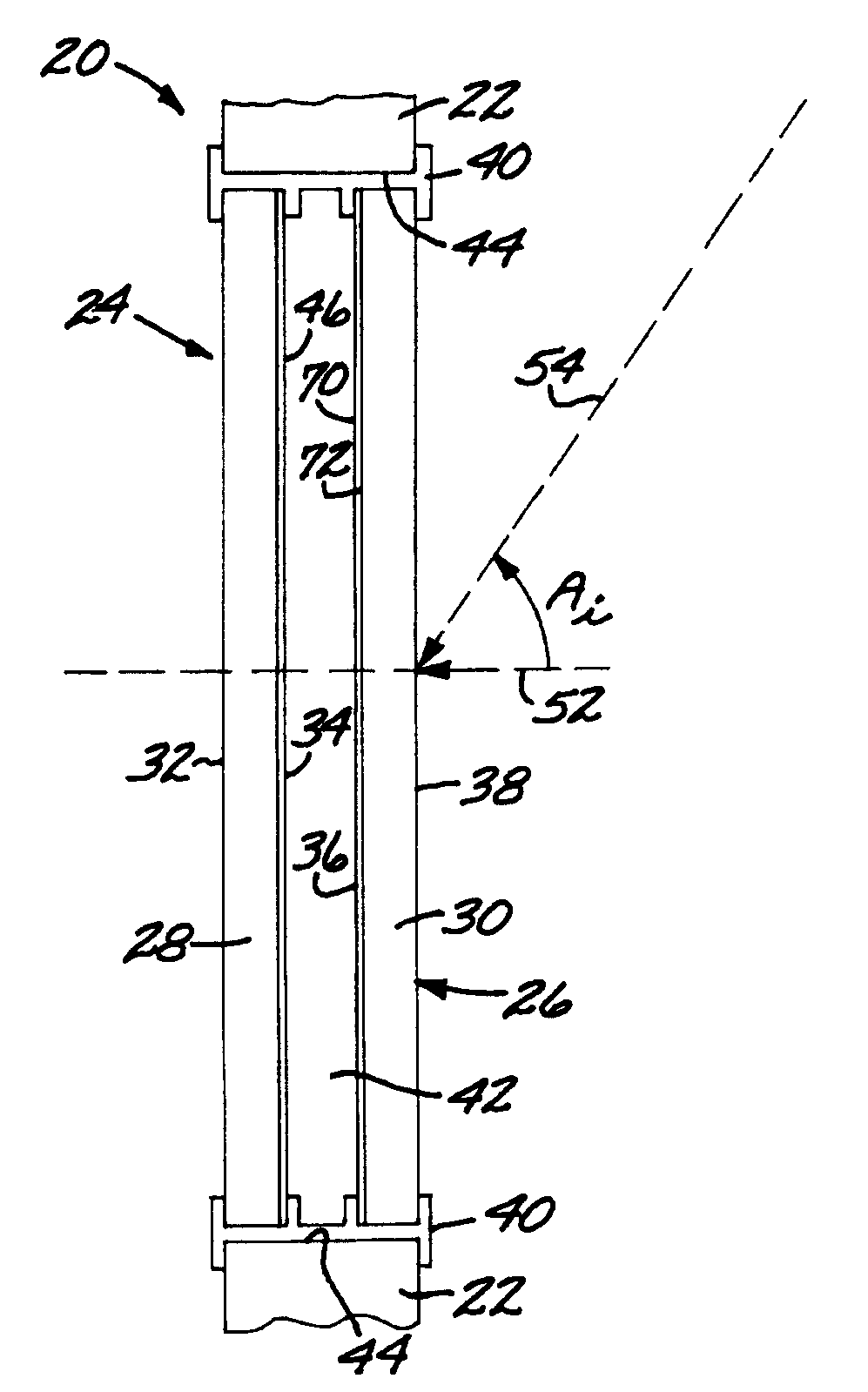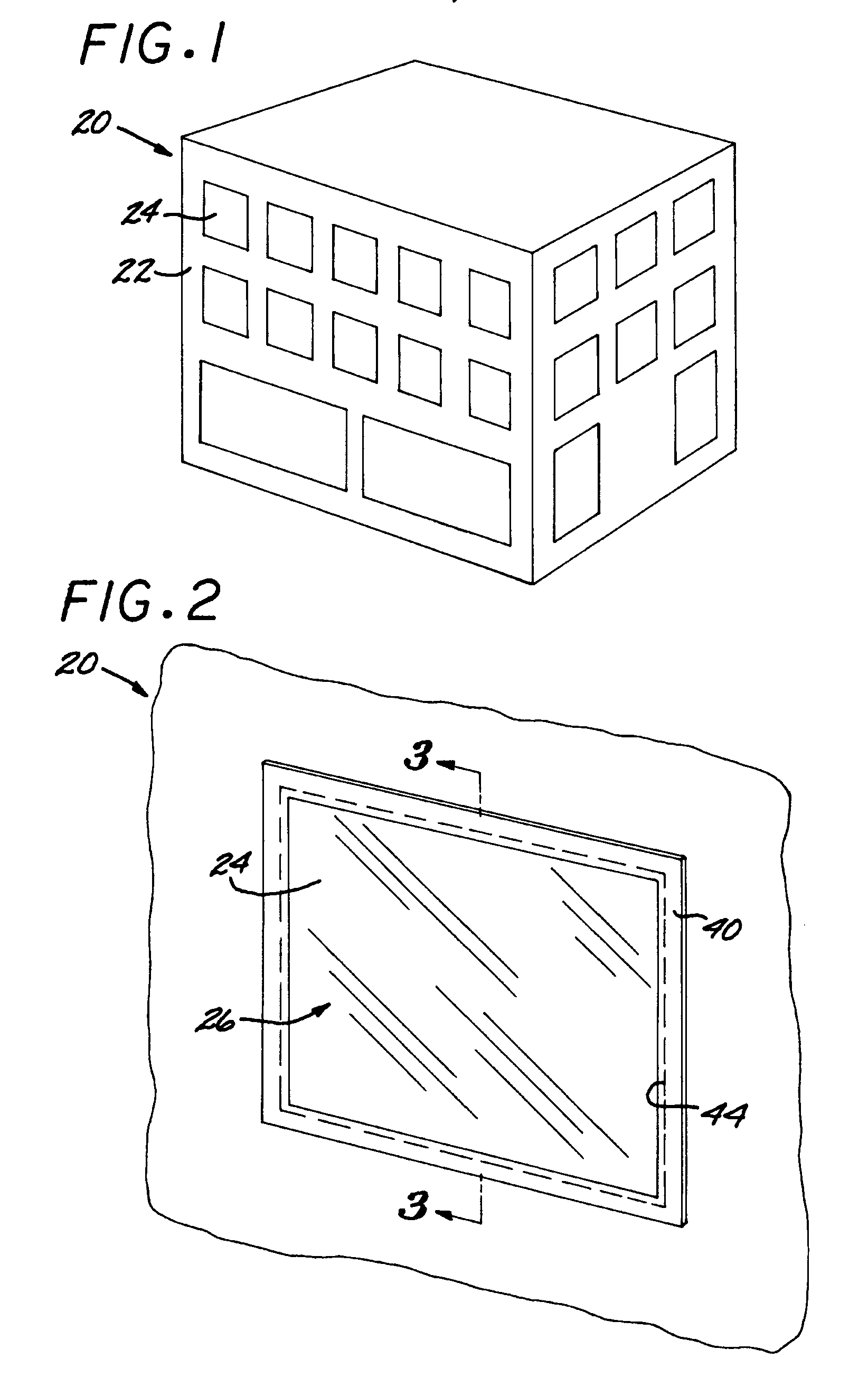[0010]The window may have two or more panes of glass. For example, the building transparent window glazing may comprise two panes of glass set into a building window frame with a
dead space between the panes of glass. The
dead space may be filled with air or an
inert gas, or may be evacuated. The
dead space between the two panes of glass reduces
heat transfer through the window by conduction and
convection mechanisms, thereby providing insulation. The first surface is on one of the two panes of glass, most preferably on one of the surfaces facing the dead space.
[0011]One of the desirable features of the present approach is that it may be used in conjunction with an
infrared-reduction coating overlying (and optionally but preferably contacting) a second surface (which may be the same as the first surface, but is preferably a different surface) of the building transparent window glazing. In the case of the two-pane glazing, the optical interference coating and the
infrared-reduction coating may be on the two surfaces facing the dead space. This arrangement prevents the coatings from being damaged from sources exterior to the building or interior to the building.
[0012]The basis of the present approach is the recognition that the visible-light portion of the solar spectrum carries nearly as much
heat energy as does the infrared-light portion of the solar spectrum. Prior approaches that have emphasized only the reduction of infrared energy that would otherwise pass through the window into the building, such as those using ITO coatings on the window, have had little or no effect on the
heat energy transmitted with the visible light. Prior approaches that have reduced the visible light, such as tints on the window, have reduced the
visibility through the window of the occupants of the building in the direction normally viewed, which is roughly in the plane of the
horizon and a few degrees above and below the horizontal plane.
[0014]The present approach that attenuates visible light at higher angles of incidence may be combined with other non-directional techniques that reduce the penetration of infrared wavelengths through the window into the building, thereby addressing the
wavelength ranges that carry about 95 percent of the
heat energy in solar
radiation. For example, the window may be tinted, although tinting reduces
visibility over all angles, including 0-degree and near-0-degree angles of incidence.
[0016]One
advantage of the present approach is that it is highly flexible. The windows of a building may be given different treatments according to the nature of the scene viewed through the window and other considerations. For example, a window having little by way of a scenic view for the occupant can be given a highly effective coating and insulating treatment over its entire surface. In a case where the view is highly desirable in a particular direction, the attenuation afforded by the optical interference coating may be tailored to provide little loss of visibility in the direction of the desirable view. The optical interference coating may be intentionally spatially varied to be non-uniform over the surface of the widow. One such technique is to coat only a portion of the window with the optical interference coating, so that there is no loss of view at all through the uncoated portion (although there will be a higher
heat transmission through this uncoated portion), while other portions of the window are provided with the optical interference coating. (Spatial variation of the optical interference coating includes, but is not limited to, an absence of the optical interference coating in some areas and its presence in other areas.) For example, the window could be coated on its upper portion and / or lower portion, but left uncoated in a band from 4-7 feet from
floor level. The present approach may also be used to grade or graduate the transmission of the optical interference coating, so that different areas have different attenuations for the same higher
angle of incidence.
[0017]The multilayer
dielectric inorganic optical interference coating thus functions to some degree in the manner of an exterior window shade or
awning by reducing the intensity of the visible sunlight at higher angles of incidence. The present approach differs in visual effect from the exterior window shade or
awning in that features at the higher angles of incidence may be seen more darkly than those at lower angles of incidence, and also in that the present approach has no window shade or
awning projecting from the side of the building.
 Login to View More
Login to View More  Login to View More
Login to View More 


